

Business, Design, and Engineering: Developing Collaboration-Culture. Disrupt or be disrupted.

Traditional approaches to building great software are quickly falling by the wayside. With myriad of smaller, more nimble competitors rapidly entering the marketplace, how will your business innovate, survive and thrive? This series offers readers tactical approaches to building software that your customers love. Break down existing silos and create an environment for cross-collaborative teams: placing technology, business and user experience design at the core. This InfoQ article is part of the series “Design And Technology: Joining Forces For A Truly Competitive Advantage Content On InfoQ”. The collaboration of a company and its multidisciplinary units has never been more crucial than it is right now.
How can we unlock better collaborative rhythms within organizations that have tried and true processes that have worked for eons, but may not be working any longer? Scenario 1 Common challenges Scenario 2 The business keeps adding features or revisions. Scenario 3. Emotional Interface Design: The Gateway to Passionate Users. We’re changing.
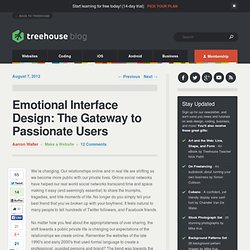
Our relationships online and in real life are shifting as we become more public with our private lives. Online social networks have helped our real world social networks transcend time and space making it easy (and seemingly essential) to share the triumphs, tragedies, and trite moments of life. No longer do you simply tell your best friend that you’ve broken up with your boyfriend. It feels natural to many people to tell hundreds of Twitter followers, and Facebook friends. No matter how you feel about the appropriateness of over sharing, the shift towards a public private life is changing our expectations of the relationships we create online. Figure 1: Kenny Meyers uses humor in his portfolio to connect with his audience. Oh how times have changed (figure 1). In Search of Strategic Relevance for UX Teams. By Jim Nieters and Laurie Pattison Published: October 6, 2008 “What … are the most salient factors in getting you to the strategy table?”
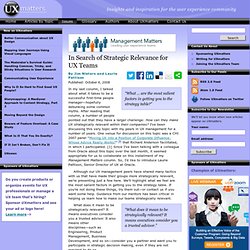
In my last column, I talked about what it takes to be a successful first-time people manager—hopefully debunking some common myths. Approaching Data with a Beginner’s Mind. In the beginner's mind there are many possibilities, in the expert's mind there are few. - Shunryu Suzuki Recently, I was asked for my opinion on a project in which a UX team was trying to represent complex relationships using a specific type of data visualization.

I asked whether that type of visualization was the best way to represent the relationships, and why that particular approach had been chosen. The answer: a designer “liked it.” Perhaps not enough foundational thinking had gone into what they were trying to accomplish. Social Seen. The opinions which we hold of one another, our relations with friends and kinsfolk are in no sense permanent, save in appearance, but are as eternally fluid as the sea itself. - Marcel Proust Whether it’s a Fortune 500 Company, a knitting circle, or a terrorist cell, anytime a group interacts, a complex and constantly shifting set of social relationships and behavioral patterns emerge.

Some of these interconnections may be apparent, but others are not. Create a Rewarding UI for Your Admins. The UX of Data. In my previous UX Magazine article, The Coming Zombie Apocalypse, I discussed how small, Web-connected devices are overturning our old-school assumptions about devices and applications.
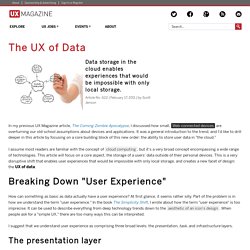
It was a general introduction to the trend, and I'd like to drill deeper in this article by focusing on a core building block of this new order: the ability to store user data in "the cloud. " I assume most readers are familiar with the concept of cloud computing, but it's a very broad concept encompassing a wide range of technologies. This article will focus on a core aspect, the storage of a users' data outside of their personal devices. Responsive UX: Taking Responsive Design a Step Further. For the last year, the concept of responsive design has been a hot, hot topic in the design and front-end community.
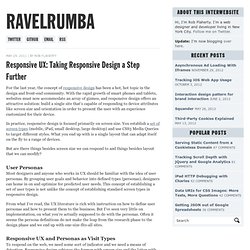
With the rapid growth of smart phones and tablets, websites must now accommodate an array of gizmos, and responsive design offers an attractive solution: build a single site that’s capable of responding to device attributes like screen size and orientation in order to present the user with an experience customized for their device. In practice, responsive design is focused primarily on screen size. You establish a set of screen types (mobile, iPad, small desktop, large desktop) and use CSS3 Media Queries to target different styles. Design Is a Process, Not a Methodology. Step 4: Eliciting and Defining Clear Product Requirements “Requirements definition connects the dots between research and design….
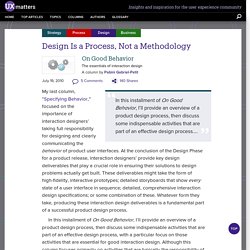
Your ability to see through the eyes of the personas and clearly define needs before seeking solutions will provide tremendous value in product definition.” Empathic design. Empathic design is a user-centered design approach that pays attention to the user's feelings toward a product.[1][2][3] The empathic design process is sometimes mistakenly referred to as Empathetic design.[4] Characteristics of empathic design[edit] The foundation of empathic design is observation and the goal is to identify latent customer needs in order to create products that the customers don’t even know they desire or, in some cases, solutions that customers have difficulty envisioning due to lack of familiarity with the possibilities offered by new technologies or because locked in an old mindset.
Empathic design relies on observation of consumers as opposed to traditional market research[5] which relies on consumer inquiry with the intention to avoid possible biases in surveys and questions, and minimizes the chance that consumers will provide false information. User-centered design. The chief difference from other product design philosophies is that user-centered design tries to optimize the product around how users can, want, or need to use the product, rather than forcing the users to change their behavior to accommodate the product.
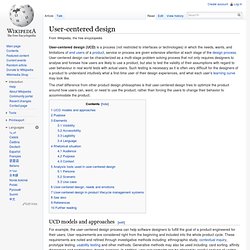
UCD models and approaches[edit] For example, the user-centered design process can help software designers to fulfill the goal of a product engineered for their users. User requirements are considered right from the beginning and included into the whole product cycle. These requirements are noted and refined through investigative methods including: ethnographic study, contextual inquiry, prototype testing, usability testing and other methods. Focus on User Experience. Yesterday we attended a workshop hosted by JISC at their office in London. The workshop focused on User-Centred Design, an approach to user interface design in which a users requirements are given extensive thought throughout the process. The philosophy behind this is a design should focus on your user’s actual goals and needs.
This may sound obvious, but in practice it is very easy to charge head on into a design that the designer likes, but may not actually give the best user experience. The Essence of Interaction Design—Part I: Designing Virtual Contexts for Interaction. By Pabini Gabriel-Petit Published: January 5, 2011 “Interaction design is absolutely central to the design of application user experiences —whether for the desktop, Web, mobile devices, or other handheld devices….”
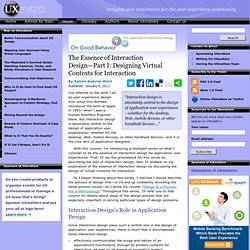
UI.